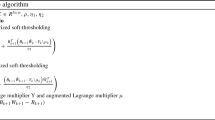Abstract
A sparse and collaborative representation-based detector (SCRD) is proposed in this work. It uses the benefits of both sparse and collaborative representation for anomalous target detection. Anomalies compose the minority of image scene. So, sparse representation that involves a low number of dictionary’s atoms is an appropriate approach for estimating of targets. In contrast, the background pixels compose the majority of image scene. So, collaborative representation, which utilizes all atoms of dictionary, is a desired representation to model the background data. The used dictionary in sparse representation is constituted from the anomalous pixels, while the used dictionary in collaborative representation is constituted from the background ones. The proposed SCRD method has high probability of detection and low computations in comparison with several state-of-the-art anomaly detectors. The superior performance of SCRD is shown on both synthetic and real hyperspectral images.







Similar content being viewed by others
References
Landgrebe, D.: Hyperspectral image data analysis. IEEE Signal Process. Mag. 19(1), 17–28 (2002)
Wu, Y., Wang, P., Wang, S., Liu, J., Gao, M., Wei, R., Gao, X.: Hyperspectral imaging and analysis for sketch painting. Optik 212, 164686 (2020)
Roy, S.K., Krishna, G., Dubey, S.R., Chaudhuri, B.B.: HybridSN: exploring 3-D to 2-D CNN feature hierarchy for hyperspectral image classification. IEEE Geosci. Remote Sens. Lett. 17(2), 277–281 (2020)
Bakhshi, G., Shahtalebi, K., Momeni, M.: A new adaptive algorithm for target detection in hyperspectral images. Infrared Phys. Technol. 99, 222–230 (2019)
Cherouat, S., Soltani, F., Schmitt, F., et al.: Using fractal dimension to target detection in bistatic SAR data. Signal Image Video Process. 9(2), 365–371 (2015)
Zhao, C., Li, C., Yao, X., Li, W.: Real-time kernel collaborative representation-based anomaly detection for hyperspectral imagery. Infrared Phys. Technol. 107, 103325 (2020)
Wei, L., Xuchu, Y.: Small target extraction based on independent component analysis for hyperspectral imagery. Geo-spatial Inf. Sci. 9(2), 103–107 (2006)
Imani, M., Ghassemian, H.: Local histogram and discriminative learning-based hyperspectral data classification. Remote Sens. Lett. 8(1), 86–95 (2017)
Song, S., Liu, Z., Huang, M., Zhu, Q., Qin, J., Kim, M.S.: Detection of fish bones in fillets by Raman hyperspectral imaging technology. J. Food Eng. 272, 109808 (2020)
Tu, B., Yang, X., Li, N., Zhou, C., He, D.: Hyperspectral anomaly detection via density peak clustering. Pattern Recognit. Lett. 129, 144–149 (2020)
Zhao, C., Zhang, L.: Spectral-spatial stacked autoencoders based on low-rank and sparse matrix decomposition for hyperspectral anomaly detection. Infrared Phys. Technol. 92, 166–176 (2018)
Zhao, R., Du, B., Zhang, L., Zhang, L.: A robust background regression based score estimation algorithm for hyperspectral anomaly detection. ISPRS J. Photogramm. Remote Sens. 122, 126–144 (2016)
Mohammadi, M.M., Moqiseh, A., Nayebi, M.M.: Surveillance radar target detection with the Fourier-Hough transform. In: 2008 International Radar Symposium, Wroclaw, pp. 1–4 (2008)
Ren, H., Chang, C.-I.: Automatic spectral target recognition in hyperspectral imagery. IEEE Trans. Aerosp. Electron. Syst. 39(4), 1232–1249 (2003)
Xiong, Y., Zuo, R., Wang, K., Wang, J.: Identification of geochemical anomalies via local RX anomaly detector. J. Geochem. Explor. 189, 64–71 (2018)
Nasrabadi, N.M.: Regularization for spectral matched filter and RX anomaly detector. In: Proceedings of SPIE, vol. 6966, art. no. 696604 (2008)
Chang, S., Du, B., Zhang, L.: BASO: a background-anomaly component projection and separation optimized filter for anomaly detection in hyperspectral images. IEEE Trans. Geosci. Remote Sens. 56(7), 3747–3761 (2018)
Schaum, A.P.: Hyperspectral anomaly detection beyond RX. In: Proceedings of SPIE, vol. 6565, art. no. 656502 (2007)
Zhou, J., Kwan, C., Ayhan, B., Eismann, M.T.: A novel cluster kernel RX algorithm for anomaly and change detection using hyperspectral images. IEEE Trans. Geosci. Remote Sens. 54(11), 6497–6504 (2016)
Guo, Q., Zhang, B., Ran, Q., Gao, L., Li, J., Plaza, A.: Weighted- RXD and linear filter-based RXD: improving background statistics estimation for anomaly detection in hyperspectral imagery. IEEE J. Sel. Top. Appl. Earth Observ. Remote Sens. 7(6), 2351–2366 (2014)
Li, W., Du, Q.: Collaborative representation for hyperspectral anomaly detection. IEEE Trans. Geosci. Remote Sens. 53(3), 1463–1474 (2015)
Li, J., Zhang, H., Zhang, L., Ma, L.: Hyperspectral anomaly detection by the use of background joint sparse representation. IEEE J. Sel. Top. Appl. Earth Observ. Remote Sens. 8(6), 2523–2533 (2015)
Su, H., Wu, Z., Du, Q., Du, P.: Hyperspectral anomaly detection using collaborative representation with outlier removal. IEEE J. Sel. Top. Appl. Earth Observ. Remote Sens. 11(12), 5029–5038 (2018)
Imani, M.: Anomaly detection using morphology-based collaborative representation in hyperspectral imagery. Eur. J. Remote Sens. 51(1), 457–471 (2018)
Ülkü, İ., Töreyin, B.U.: Sparse coding of hyperspectral imagery using online learning. Signal Image Video Process. 9, 959–966 (2015)
Huyan, N., Zhang, X., Zhou, H., Jiao, L.: Hyperspectral anomaly detection via background and potential anomaly dictionaries construction. IEEE Trans. Geosci. Remote Sens. 57(4), 2263–2276 (2019)
Revathi, A.R., Kumar, D.: An efficient system for anomaly detection using deep learning classifier. Signal Image Video Process. 11, 291–299 (2017)
Li, S., Liu, C., Yang, Y.: Anomaly detection based on sparse coding with two kinds of dictionaries. Signal Image Video Process. 12, 983–989 (2018)
Schweizer, S.M., Moura, J.M.F.: Efficient detection in hyperspectral imagery. IEEE Trans. Image Process. 10(4), 584–597 (2001)
Xu, Y., Wu, Z., Li, J., Plaza, A., Wei, Z.: Anomaly detection in hyperspectral images based on low-rank and sparse representation. IEEE Trans. Geosci. Remote Sens. 54(4), 1990–2000 (2016)
Wang, Z., Martin, R.: Model-free posterior inference on the area under the receiver operating characteristic curve. J. Stat. Plan. Inference (2020). https://doi.org/10.1016/j.jspi.2020.03.008
Author information
Authors and Affiliations
Corresponding author
Additional information
Publisher's Note
Springer Nature remains neutral with regard to jurisdictional claims in published maps and institutional affiliations.
Rights and permissions
About this article
Cite this article
Imani, M. Sparse and collaborative representation-based anomaly detection. SIViP 14, 1573–1581 (2020). https://doi.org/10.1007/s11760-020-01709-0
Received:
Revised:
Accepted:
Published:
Issue Date:
DOI: https://doi.org/10.1007/s11760-020-01709-0




